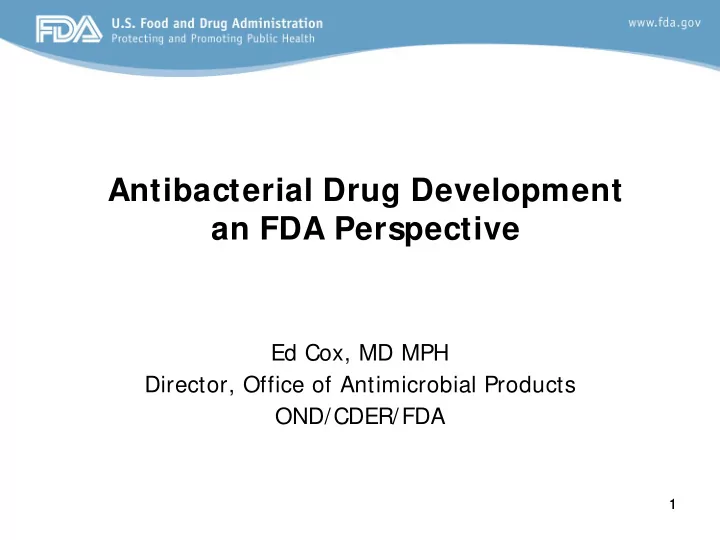

Antibacterial Drug Development an FDA Perspective Ed Cox, MD MPH Director, Office of Antimicrobial Products OND/CDER/FDA 1 1
Background • Development of new antibacterial agents is essential to meet patient needs – Need therapies to treat patients with infections today – Know we will need new options in the future • Two development prongs - ideally – Unmet need – trying to catch up to meet critical public health needs in areas where we are behind – Ongoing development – so new options are available to address the needs that we know will arise in the years ahead 2
Challenges in Studying Antibacterial Drugs • Biology of the acute bacterial infectious diseases – Acute illness - Early doses important – Urgent need to initiate therapy for serious infections – Diagnostic uncertainty – Micro diagnosis – time delayed – detection limits of common techniques – better diagnostics could help – Effects of prior therapy or concomitant therapy – may cloud assessment of the test drug (NI trials) – Heterogeneity in outcomes dependent upon multiple factors (e.g., patient factors) • Limitations of the available information on natural history of disease to estimate treatment effect • Different compared to many other therapeutic areas 3 3
Antibacterial Drug Development • Extent and breadth of antibacterial drug development seems below level needed to meet patient needs • Limited development activity in some therapeutic indications • Balancing precision of assessments of safety and efficacy with feasibility & public health need for new options – areas of unmet need • Tools & approaches to facilitate study of new antibacterial drugs 4
Unmet Need • Serious or life-threatening bacterial infections where patients lack satisfactory therapeutic options • Risk / Benefit in the setting of unmet need • More streamlined development – get drugs to patients sooner in areas of unmet need • Greater uncertainty / risk with a more limited development program • An indication that reflects the more limited development program – targeting use in settings where other available drugs not satisfactory 5
Unmet Need – Data Sources • Preclinical Data – what role can this data contribute? – Mechanism of action / impact of resistance to other drugs – Animal models of infection • Clinical Data – PK data to estimate appropriate dosing in indicated population(s) – Data from a trial in patients with serious or life-threatening infections (role of patients with “susceptible” infections) • Approaches to analyzing data from across multiple body sites • Clinical trial may enroll patients with organisms resistant to other therapies and patients with organisms susceptible to other therapies • Degree of precision of estimates of safety and efficacy if indication is for patients who lack satisfactory treatment options – Additional data from limited experience in patients with limited therapeutic options b/c of “resistant” organisms 6
Tools • Better means to evaluate safety and efficacy • Can we learn more from the data that is accrued during development? • Can Bayesian approaches help? • Approaches to analyzing data in a trial enrolling patients with infections from across multiple body sites • Can endpoints be further developed and standardized to facilitate and enrich development? • Are there clinical trials procedures that are being done that do not add value? • Can clinical trial networks facilitate the study of antibacterial drugs given the inherent challenges in studying antibacterial drugs for these acute diseases 7
Thank you 8
Recommend
More recommend